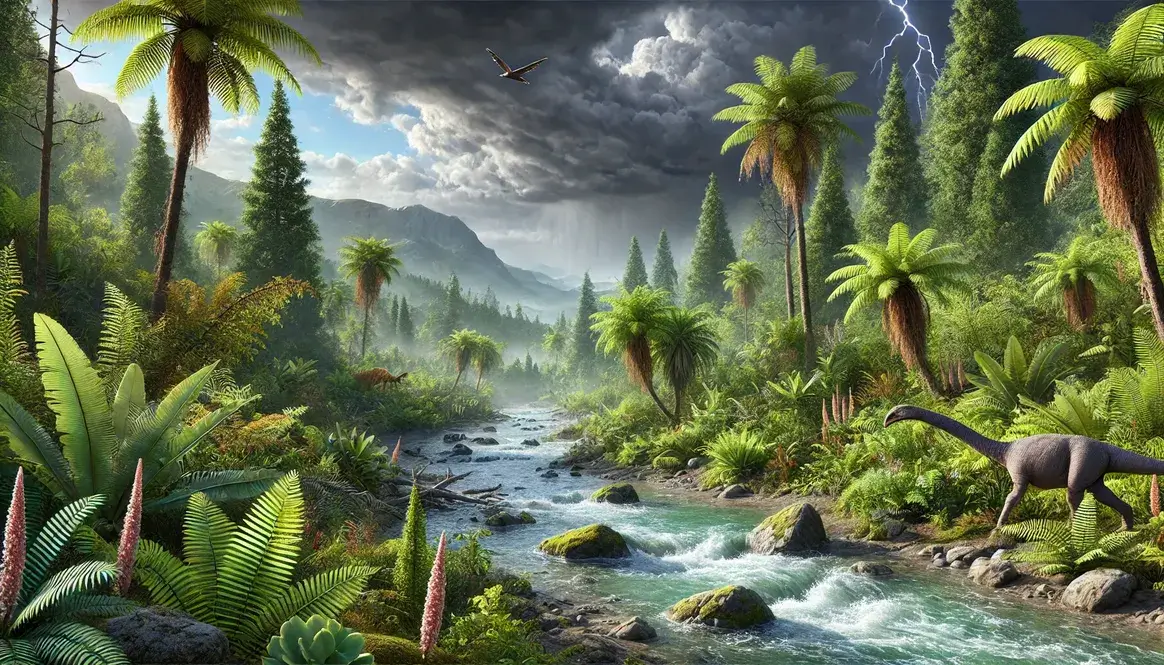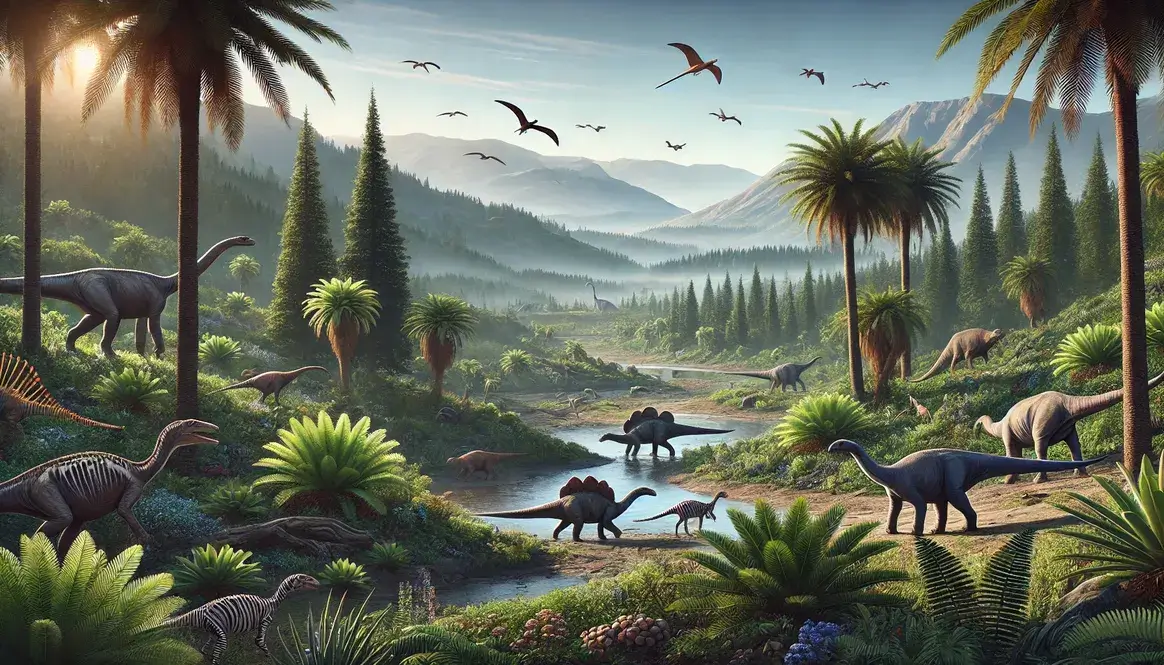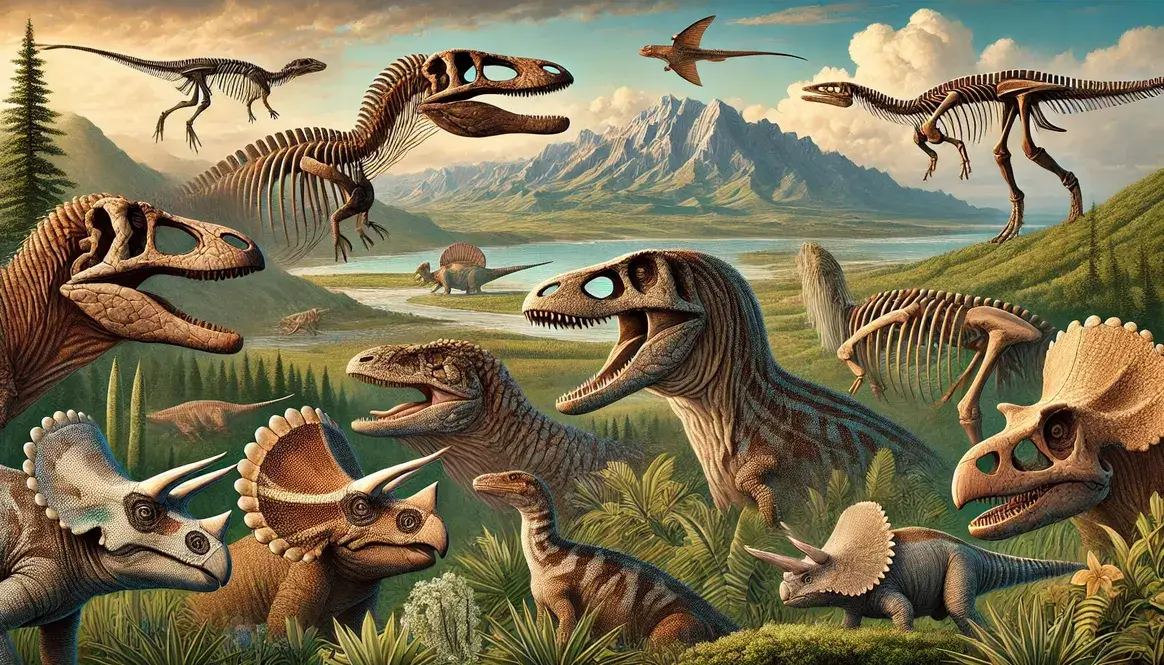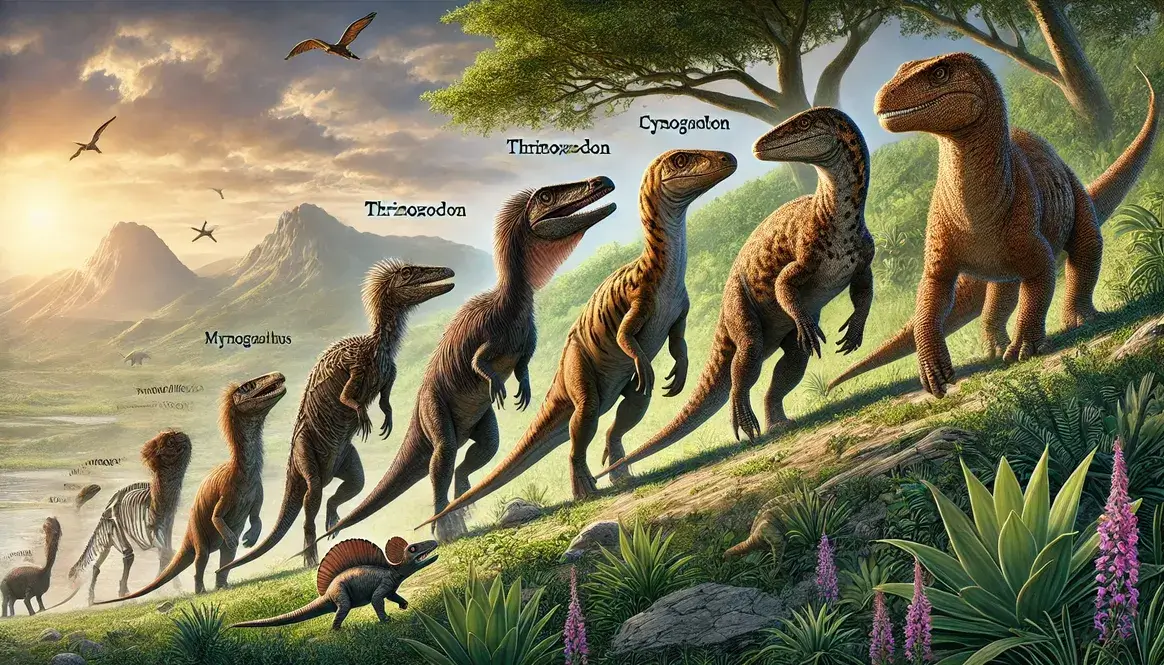To understand the impact of the Carnian Pluvial Event, we need to set the stage by exploring the world as it was in the Triassic Period. This era laid the foundation for one of the most significant climate events in Earth’s history.
The Triassic Period, spanning from 252 to 201 million years ago, was a time of great change on Earth. It followed the largest mass extinction in our planet’s history and set the stage for the rise of the dinosaurs. Before the Carnian Pluvial Event shook things up, the world looked quite different from what we know today.
Imagine a vast supercontinent called Pangaea, surrounded by a single ocean named Panthalassa. The climate was generally warm and dry, with extreme seasons. Deserts covered large parts of the land, while conifer forests and ferns dominated the less arid areas. The oceans teemed with marine reptiles and primitive fish, while on land, early dinosaurs were just beginning to make their mark.
The Carnian stage, lasting from about 237 to 227 million years ago, was right in the middle of the Triassic Period. It was during this time that a significant climate event occurred, which would reshape life on Earth in ways that still influence our world today.
Onset of the Carnian Pluvial Event
The beginning of the Carnian Pluvial Event marked a turning point in the Triassic Period. This section explores how this remarkable climate shift began and the early signs that hinted at the dramatic changes to come.
Defining the Carnian Pluvial Event
The Carnian Pluvial Event, also known as the Carnian Pluvial Episode or the Carnian Humid Episode, was a period of increased rainfall and humidity that occurred around 234 to 232 million years ago. This event marked a significant shift from the typically dry Triassic climate to a much wetter one.
Key characteristics of the Carnian Pluvial Event include:
- A sudden increase in global rainfall
- A shift from arid to humid conditions
- Major changes in both terrestrial and marine ecosystems
- Lasting for approximately 1-2 million years
This event was not just a brief rainy season but a prolonged period that had far-reaching consequences for life on Earth.
Early Signs of Change
The first hints of this major climate shift came from geological evidence. Scientists studying rock formations from the Carnian stage noticed a distinct change in the types of sediments being deposited. Instead of the red beds typical of arid environments, they found layers indicating increased rainfall and river activity.
Paleontologists also began to notice changes in the fossil record. Plant fossils showed a sudden shift from drought-resistant species to those that thrive in wetter conditions. Animal fossils revealed changes too, with some groups declining while others began to diversify rapidly.
These early signs were just the beginning of a major transformation that would reshape the Triassic world.
Peak of the Carnian Pluvial Event
As the Carnian Pluvial Event reached its zenith, the world experienced unprecedented changes in its climate patterns. This section delves into the global impact of this event at its peak and explores the potential causes behind such a dramatic shift.
Global Rainfall Patterns
At the height of the Carnian Pluvial Event, Earth experienced a dramatic increase in rainfall. This wasn’t just a local phenomenon – evidence suggests it was a global event, affecting ecosystems worldwide.
The extent and intensity of the increased precipitation were remarkable. Estimates suggest that rainfall may have increased by as much as 30% in some regions. To put this into perspective, imagine if the amount of rain in your area suddenly increased by a third – it would have a massive impact on the environment!
However, the rainfall wasn’t uniform across the globe. Some areas experienced more dramatic changes than others. Here’s a simplified table showing how different regions might have been affected:
| Region | Pre-Event Climate | During Event Climate |
|---|---|---|
| Equatorial | Hot and dry | Hot and very wet |
| Mid-latitudes | Seasonal and semi-arid | Humid with frequent rain |
| Polar | Cool and dry | Cool and wet |
Causes of Increased Humidity
Scientists have proposed several theories to explain what triggered the Carnian Pluvial Event. One of the leading ideas points to intense volcanic activity as a major culprit.
During this time, there was a surge in volcanic eruptions, particularly in an area that is now western Canada. These eruptions, known as the Wrangellia large igneous province, spewed massive amounts of carbon dioxide into the atmosphere.
This increase in atmospheric CO2 led to:
- Global warming
- An intensified water cycle
- Increased rainfall worldwide
It’s like turning up the heat under a pot of water – as the temperature rises, more water evaporates, leading to more clouds and more rain.
Other factors may have contributed too, such as changes in ocean circulation patterns or the position of the continents. But volcanic activity remains the prime suspect in this climate mystery.
Environmental Transformations During the Event
The Carnian Pluvial Event didn’t just change the weather; it reshaped entire ecosystems. From lush new forests on land to shifting ocean currents, the world underwent a dramatic transformation. Let’s explore how these changes unfolded both on terra firma and beneath the waves.
Terrestrial Ecosystem Changes
The increased rainfall during the Carnian Pluvial Event dramatically altered land environments. Plant communities underwent significant shifts as the climate changed.
Drought-resistant plants that had dominated the landscape began to decline. In their place, moisture-loving plants started to thrive. Ferns and early conifers spread rapidly, creating lush, green landscapes where deserts once stood.
This change in plant life had a ripple effect on the entire ecosystem. New types of soils developed, enriched by the decomposition of abundant plant matter. Rivers and lakes expanded, creating new freshwater habitats.
These changes provided new opportunities for animal life. Some groups, unable to adapt to the wetter conditions, declined. Others, including the early dinosaurs, found these new environments perfect for expansion and diversification.
Marine Ecosystem Upheaval
The oceans weren’t spared from the effects of the Carnian Pluvial Event. The increased rainfall and warmer temperatures led to significant changes in ocean chemistry and circulation patterns.
- Ocean Chemistry: The influx of freshwater from increased rainfall changed the salinity of the oceans, especially in coastal areas. This affected marine life adapted to specific salt concentrations.
- Ocean Circulation: Changes in temperature and salinity altered ocean currents, affecting nutrient distribution and marine ecosystems globally.
- Sea Level: The warmer climate likely caused some melting of polar ice, leading to a rise in sea levels.
These changes had profound effects on marine life. Many reef-building organisms, which had dominated the Triassic seas, suffered major setbacks. In their place, new groups of marine life began to flourish, reshaping the underwater landscape.
This period of change in the oceans set the stage for the evolution of many modern marine groups. It’s a reminder of how closely linked the earth’s climate, oceans, and life are – a change in one can lead to transformations in all.
Biological Responses to the Carnian Pluvial Event
The Carnian Pluvial Event didn’t just change the physical landscape; it triggered a cascade of biological responses. From the smallest plants to the largest animals, life on Earth adapted, evolved, and sometimes perished in the face of these new conditions.
Plant Adaptations and Diversification
As the climate shifted from arid to humid, the plant world underwent a dramatic transformation. The Triassic flora that had adapted to dry conditions found itself struggling in this new, wetter world.
New plant groups evolved to take advantage of the increased moisture. Ferns and horsetails, which require damp conditions to reproduce, spread rapidly across the landscape. Conifers, which had already been present, diversified into new forms better suited to the humid climate.
One of the most significant changes was the spread of moisture-loving plants. These included:
- Cycads: Palm-like plants that thrived in the new humid conditions
- Bennettitales: Seed plants that resembled modern cycads but were more closely related to flowering plants
- Early ancestors of flowering plants: While true flowering plants wouldn’t appear until later, their precursors began to evolve during this time
This shift in plant life had far-reaching consequences for the entire ecosystem, providing new food sources and habitats for animal life.
Animal Life in a Changing World
The animal kingdom experienced its own upheavals during the Carnian Pluvial Event. Some groups that had been well-adapted to the previous arid conditions struggled to survive, leading to extinctions and turnovers in fauna.
Marine life was particularly affected. Many species of conodonts, tiny eel-like creatures that had been abundant in the oceans, went extinct during this time. Some groups of ammonites also suffered significant losses.
However, as some groups declined, others seized the opportunity to diversify and spread. New animal groups emerged, better suited to the changed conditions:
- Dinosaurs: While they had already appeared earlier in the Triassic, dinosaurs began to diversify and spread during this time
- Pterosaurs: The first flying vertebrates evolved during this period
- Early mammals: Small, nocturnal creatures that would eventually give rise to all modern mammals
These changes set the stage for the ecosystems that would dominate the rest of the Mesozoic era.
To summarize the key biological changes during the Carnian Pluvial Event, here’s a table showing the major shifts in plant and animal life:
| Group | Before the Event | During/After the Event |
|---|---|---|
| Plants | Drought-resistant conifers and seed ferns | Ferns, horsetails, cycads, diverse conifers |
| Marine Animals | Diverse conodonts and ammonites | Decline in conodonts and some ammonites, rise of new marine reptiles |
| Terrestrial Vertebrates | Therapsids (mammal-like reptiles) dominant | Early dinosaurs, pterosaurs, and mammals emerging |
| Insects | Limited diversity | Increased diversity, especially among water-loving groups |
This table illustrates the dramatic shift in ecosystems brought about by the Carnian Pluvial Event, highlighting how the increased humidity led to a restructuring of both plant and animal communities.
These changes set the stage for the ecosystems that would dominate the rest of the Mesozoic era.
The Dinosaur Connection
The Carnian Pluvial Event played a crucial role in the rise of one of the most iconic groups of animals in Earth’s history: the dinosaurs. This section explores how this climate event influenced the early evolution of dinosaurs and set the stage for their eventual dominance.
Early Dinosaur Evolution
While dinosaurs had already evolved before the Carnian Pluvial Event, they were relatively rare and not particularly diverse. The dramatic climate change brought about by the event created new opportunities for these early dinosaurs.
The wetter conditions led to an explosion of plant life, providing more food for herbivorous dinosaurs. This, in turn, supported a greater number of carnivorous dinosaurs. The changing landscapes also created new habitats and ecological niches that dinosaurs were well-suited to fill.
During this time, we see evidence of dinosaur groups beginning to diversify and spread. Early members of major dinosaur lineages, such as theropods (meat-eating dinosaurs) and sauropodomorphs (long-necked plant-eaters), began to appear and evolve rapidly.
Setting the Stage for Dinosaur Dominance
The Carnian Pluvial Event had long-term impacts on dinosaur evolution that extended far beyond its immediate timeframe. By reshaping ecosystems and eliminating some competitors, it created conditions that allowed dinosaurs to thrive.
New ecological niches emerged as a result of the changed climate and vegetation. Dinosaurs, with their upright posture and efficient respiratory systems, were well-equipped to take advantage of these opportunities. This gave them an edge over other reptile groups that were more constrained by their physiology.
The event also coincided with, and may have contributed to, the decline of some groups that had previously dominated terrestrial ecosystems, such as certain types of therapsids (mammal-like reptiles). As these groups waned, dinosaurs were able to expand into their ecological roles.
While dinosaurs wouldn’t achieve total dominance until the Jurassic Period, the Carnian Pluvial Event set them on the path to becoming the most successful land animals for the next 160 million years.
Aftermath and Legacy of the Carnian Pluvial Event
The Carnian Pluvial Event, like all major climate shifts, eventually came to an end. But its effects would continue to shape life on Earth long after the rains subsided. This section examines the aftermath of the event and its enduring legacy.
Return to “Normal” Conditions
After about 1-2 million years of increased humidity, the climate began to shift back towards drier conditions. This transition wasn’t instantaneous but occurred gradually over thousands of years.
As rainfall decreased, some of the lush forests that had spread during the humid period began to recede. Desert environments, which had diminished during the event, started to expand once again in certain regions.
Ecosystems that had been transformed by the Carnian Pluvial Event now faced another period of change as they adapted to the returning aridity. Some plant and animal groups that had thrived during the humid period declined, while others that were better suited to drier conditions began to recover.
Long-term Consequences
Despite the return to drier conditions, the Carnian Pluvial Event left a lasting mark on global ecosystems. Many of the plant and animal groups that had evolved or diversified during this time continued to thrive and evolve.
Some of the long-term consequences included:
- Increased diversity of conifers and other plant groups
- The establishment of dinosaurs as a significant component of terrestrial ecosystems
- Changes in ocean chemistry and circulation that persisted into later periods
The Carnian Pluvial Event serves as an important case study for understanding climate-driven evolutionary events. It demonstrates how relatively rapid changes in climate can have profound and long-lasting effects on life on Earth.
The Carnian Pluvial Event in Earth’s History
When we look at the grand sweep of Earth’s history, the Carnian Pluvial Event stands out as a pivotal moment. Its significance extends beyond the Triassic Period, offering valuable insights into climate change and its impact on life.
In the context of other major climate events, the Carnian Pluvial Event is noteworthy for its relatively rapid onset and the dramatic changes it triggered. While not as severe as the mass extinctions at the end of the Permian or Cretaceous periods, it nevertheless reshaped ecosystems and redirected the course of evolution.
The event also provides important lessons for understanding modern climate change. It shows us how:
- Relatively rapid climate shifts can have profound effects on global ecosystems
- Changes in one part of the Earth system (like increased volcanic activity) can trigger far-reaching consequences
- Some species can adapt and thrive in the face of change, while others struggle or go extinct
As we face the challenges of anthropogenic climate change today, the Carnian Pluvial Event reminds us of the powerful interplay between climate, ecosystems, and evolution. It underscores the importance of understanding and protecting the delicate balance of our planet’s systems.









